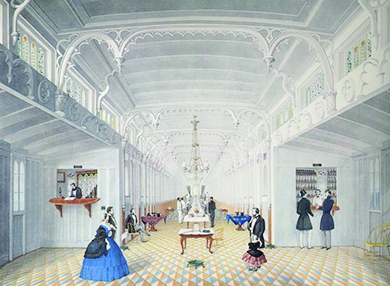| << Chapter < Page | Chapter >> Page > |
Sometimes the cotton was dried before it was ginned (put through the process of separating the seeds from the cotton fiber). The cotton gin allowed a slave to remove the seeds from fifty pounds of cotton a day, compared to one pound if done by hand. After the seeds had been removed, the cotton was pressed into bales. These bales, weighing about four hundred to five hundred pounds, were wrapped in burlap cloth and sent down the Mississippi River.
Visit the Internet Archive to watch a 1937 WPA film showing cotton bales being loaded onto a steamboat.
As the cotton industry boomed in the South, the Mississippi River quickly became the essential water highway in the United States. Steamboats, a crucial part of the transportation revolution thanks to their enormous freight-carrying capacity and ability to navigate shallow waterways, became a defining component of the cotton kingdom. Steamboats also illustrated the class and social distinctions of the antebellum age. While the decks carried precious cargo, ornate rooms graced the interior. In these spaces, whites socialized in the ship’s saloons and dining halls while black slaves served them ( [link] ).

Investors poured huge sums into steamships. In 1817, only seventeen plied the waters of western rivers, but by 1837, there were over seven hundred steamships in operation. Major new ports developed at St. Louis, Missouri; Memphis, Tennessee; and other locations. By 1860, some thirty-five hundred vessels were steaming in and out of New Orleans, carrying an annual cargo made up primarily of cotton that amounted to $220 million worth of goods (approximately $6.5 billion in 2014 dollars).
New Orleans had been part of the French empire before the United States purchased it, along with the rest of the Louisiana Territory, in 1803. In the first half of the nineteenth century, it rose in prominence and importance largely because of the cotton boom, steam-powered river traffic, and its strategic position near the mouth of the Mississippi River. Steamboats moved down the river transporting cotton grown on plantations along the river and throughout the South to the port at New Orleans. From there, the bulk of American cotton went to Liverpool, England, where it was sold to British manufacturers who ran the cotton mills in Manchester and elsewhere. This lucrative international trade brought new wealth and new residents to the city. By 1840, New Orleans alone had 12 percent of the nation’s total banking capital, and visitors often commented on the great cultural diversity of the city. In 1835, Joseph Holt Ingraham wrote: “Truly does New-Orleans represent every other city and nation upon earth. I know of none where is congregated so great a variety of the human species.” Slaves, cotton, and the steamship transformed the city from a relatively isolated corner of North America in the eighteenth century to a thriving metropolis that rivaled New York in importance ( [link] ).

Notification Switch
Would you like to follow the 'U.s. history' conversation and receive update notifications?